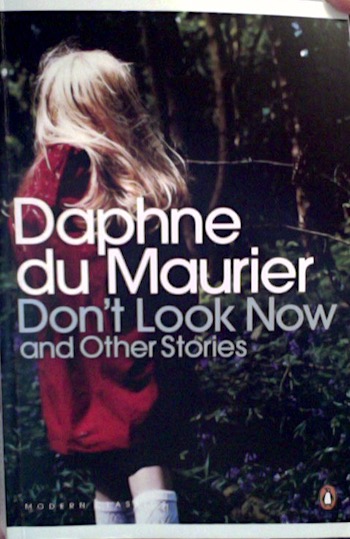Inspiring Older Readers
 posted on 06 Mar 2022
posted on 06 Mar 2022
Don’t Look Now & Other Stories by Daphne du Maurier
When I was a bookseller I must have handled hundreds, possibly thousands, of Daphne du Maurier’s books. At that time Penguin published every title and while du Maurier was perhaps no longer at the height of her popularity her books still sold in dependable quantities alongside other popular Penguin authors such as H.E. Bates and Miss Read. Shamefully, it never crossed my mind to actually read one of her books, but recently I found a secondhand copy of the handsomely jacketed Penguin Modern Classics edition of Don’t Look Now & Other Stories and in a very belated attempt to address this omission I read it over the weekend.
The first thing to say is that while I knew du Maurier as a prolific novelist it had never struck me that she was almost as prolific a short story writer, with at least half-a-dozen collections to her name. This particular volume seems to represent her longer short stories; there are only five in the book – Don’t Look Now; Not After Midnight; A Border-Line Case; The Way of the Cross; and The Breakthrough – but at forty to fifty pages each they make a substantial volume. Their length was in their favour, I thought
The title story will be familiar to many from the Nicolas Roeg film of 1973 starring Julie Christie and Donald Sutherland – a quintessentially 70s film perhaps more known for its atmospheric photography of Venice and its erotic love scenes than it is for any faithful rendition of du Maurier’s source material. John and Laura, a comfortably off couple in early middle age are holidaying in Venice where they are grieving the recent death of their young daughter from meningitis. They meet elderly twin sisters, one of whom is blind and apparently prone to something akin to fugue states in which she receives messages from the after-life. The blind sister says that she can see John and Laura’s dead daughter and that the girl is happy but has an urgent message for her parents: they should leave Venice. What follows is brilliantly done. This is without doubt the best story of the collection and I suspect has aged far more gracefully than the film. I found it absolutely compelling. I didn’t find the others quite up to the same standard, but they all have something to commend them.
In Not After Midnight the setting is Greece and a similar mixture of the gothic, the paranormal and the sinister is cleverly blended with classical mythology. I thought that this story on balance was less well-executed than the title story but was carried along by the story-telling and brilliant scene-setting.
In A Border-Line Case a young woman travels to Ireland following the sudden death of her father. She hopes to find an old regimental friend of her father’s and in doing so understand why he considered this man so important in his life. This is quite a curious story. Its somewhat contrived plot device lets it down but again brilliant story-telling and scene-setting made me keep reading.
The Way of the Cross is the longest of the stories and is set in Jerusalem as a party of village church-goers find their guided tour of the Holy City going disastrously wrong. Each of the party, Judas-like, will betray someone they are close to, or will be betrayed (in some cases by themselves and their own weaknesses). This is the story that came closest to outstaying its welcome but ultimately and unexpectedly I found it rather affecting, with some of the individual characters and events marvellously handled.
The Breakthrough is probably the weakest story in terms of its central idea. An electrical engineer finds himself seconded to a mysterious government team that has ‘gone rogue’ and is researching the after-life and in particular how to harness the life-force that is expended as we die. Again, this is made up for by superb story-telling and descriptive writing and deceptively powerful events.
I thoroughly enjoyed these stories. They turned out to be darker and stranger and altogether more accomplished and sophisticated than I had imagined. More importantly, they are well-written and beautifully structured and each is testament to du Maurier’s narrative skills and story-telling talent. Her scene-setting and descriptive writing are superb. They may on occasion be ‘old-fashioned’ in the sense that dated attitudes or ideas mar them here and there, but generally they have aged well. In short, I had under-estimated du Maurier. She was a best-selling writer for good reason.
If you enjoy readable, well-written ‘tales’ that at their best combine the gothic, the paranormal, the sinister and the morally ambiguous, then I think you too might find much to enjoy in Daphne du Maurier’s short stories. I am already on the lookout for other volumes. They’re perfect reading for long winter afternoons.
Alun Severn
March 2022
Daphne du Maurier elsewhere on Letterpress
The Birds by Daphne du Maurier